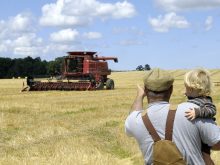Wall absent
The Saskatchewan legislature ended in June with premier Brad Wall making the statement that the session was good, but added the laughable statement that the opposition party was weak in opposing the government.
It would appear Wall has a short memory in relation to the Harper government.
When the Harper government destroyed the farmer-owned single-desk Canadian Wheat Board, the Prairie Farm Rehabilitation Administration pastures, the Indian Head Tree Nursery, reduced the benefits of AgriInvest, gutted the AgriStability program, closed agricultural research stations, burned their libraries, and reduced farmer control over farm saved seed, where was the Wall opposition?
Read Also

Crop profitability looks grim in new outlook
With grain prices depressed, returns per acre are looking dismal on all the major crops with some significantly worse than others.
These insane changes in farm policy will lead to money flowing out of Saskatchewan to foreign countries. Aside from trying to pick a fight with Alberta’s new premier, our Conservative premier has done nothing to protect rural Saskatchewan or those who depend on the food we produce.
On July 31, federal agriculture minister Gerry Ritz gave a windfall to a foreign grain company by allowing his appointed directors to “sell” the remaining assets of the CWB. This sale did not realize one penny for the federal government or farmers who paid all of its costs. This must be the new Harper economy sale.
Lyle Stewart, minister of agriculture for Saskatchewan, made the naive statement that this will lead to more competition in the marketplace. These “new” owners are not new. They were buyers before and they purchased grain from the destroyed farmer controlled CWB. Now they can play farmers off against each other to get cheaper grain.
When Wall complains about a weak opposition, he needs to look in the mirror. I hope he can see these changes are not positive to Saskatchewan and he will finally stand up for what is right and fair for its citizens, rather than always breathing Harper’s recycled air.
Eric Sagan,
Melville, Sask.
Kudos to Gerry Ritz
Reading letters to the editor, there are those that seem to continually claim how great the CWB was.
I checked the average price my farm received for wheat for a number of years: 2014 $5.89 per bushel, 2013 $6.91/bu., 2012 $6.04/bu. 2011 $6.48/bu., 2010 $3.44/bu., 2009 $4.61/bu. I don’t see any premiums for the above numbers for when the CWB had control of the marketing of my wheat.
I can also remember the initials being so low that if you delivered wheat in the fall you owed the elevator money. So much for cash flow.
Some try to claim the CWB was great at moving grain.
One recent year, I delivered close to one half of an “A” wheat contract in September of the year after the crop year closed, even though I had been willing to deliver at any time after sign-up. I just wasn’t allowed to deliver.
The CWB supporters like to think the CWB could set its price, but when you only have 11 percent of the world trade you are not a price setter. They can’t seem to understand this.
Thank you, Gerry Ritz, for taking the heat that the die-hard CWB supporters dream up and for giving farmers the opportunity to market our grain.
John Simpson,
Vermillion, Alta.
Harmful alternatives
This letter is in response to the article written by Tibor Szabo (WP Aug. 20), “Stop creating friction over neonicotinoids.”
Grain Farmers of Ontario has never threatened to use pesticides more harmful to bees. Left without the option of using neonicotinoid-treated seed due to recent regulations, many farmers will be forced to use far more detrimental products, like foliar sprays, that are arguably more harmful to the environment and farmers.
Grain Farmers of Ontario is simply looking out for the well-being of its farmer-members. Advising members to seek legal advice when bees are housed on their property ensures their own protection; many grain farmers and beekeepers have expressed concern over the return to foliar sprays, and it is important the beekeeper assumes responsibility for the hive.
Szabo also refers to the Canadian Association of Professional Apiculturists report, where Canadian honeybee losses for the winter of 2014-15 were reported. What he neglects to mention is that this number is significantly lower than the 58 percent Ontario losses reported in the winter of 2013-2014; this year’s numbers are one-fifth lower. This is largely due to the immense efforts farmers put in to minimize pollinator exposure to dust when planting corn and soybeans by using the fluency agent as well as dust deflectors.
There have been recent claims that European canola planted without neonicotinoids have higher yields than previous years when crops were planted with neonicotinoids.
However, canola harvest in the European Union has just begun, and it’s too early to be making these predictions. In addition, production totals do not include fields completely destroyed due to high insect pressures. Extremely favourable weather conditions that have not been experienced in the EU in recent years can largely be attributed to whatever increases being reported.
COLOSS, a global honey bee research organization located in Switzerland, just released a study that looks at the over wintering bee deaths in the EU from last year and two years ago. It found the overall proportion of colonies lost was estimated as 17.4 percent, twice that of the previous winter. This also correlates with the 2013 ban of neonicotinoids imposed on European farmers. Now, two years later, bee mortality has not decreased.
Grain Farmers of Ontario recognizes the importance of working together with other farmers, but it is important to do so in a way that is not harmful or detrimental to the well-being of its own farmers.
Mark Huston
Vice Chair, Grain Farmers
of Ontario














